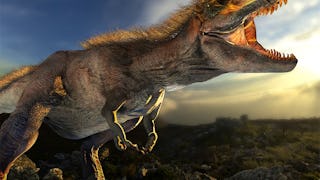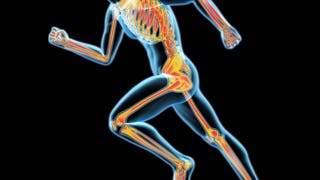Paläontologie: Early Vertebrate Evolution ist ein Kurs, der in vier Lektionen einen umfassenden Überblick über die Entstehung der Wirbeltiere vermittelt. Die Studenten werden die Vielfalt der paläozoischen Abstammungslinien in einem phylogenetischen und evolutionären Rahmen erforschen. In diesem Kurs wird die Evolution der wichtigsten Wirbeltiere untersucht, einschließlich der Entstehung von Flossen, Kiefer und Gliedmaßen der Tetrapoden. Die Studenten erforschen auch wichtige kanadische Fossilienfundorte, darunter den Burgess Shale (British Columbia), Miguasha (Quebec) und Man On The Hill (Northwest Territories). Sehen Sie sich hier eine Vorschau auf den Kurs an: https://uofa.ualberta.ca/courses/paleontology-vertebrate-evolution


Paläontologie: Frühe Wirbeltier-Evolution

Dozent: Alison Murray, Ph.D
28.919 bereits angemeldet
Bei enthalten
(1,184 Bewertungen)
Kompetenzen, die Sie erwerben
- Kategorie: Umwelt
- Kategorie: Taxonomie
- Kategorie: Biologie
- Kategorie: Biowissenschaften
- Kategorie: Umweltwissenschaft
Wichtige Details

Zu Ihrem LinkedIn-Profil hinzufügen
4 Aufgaben
Erfahren Sie, wie Mitarbeiter führender Unternehmen gefragte Kompetenzen erwerben.

In diesem Kurs gibt es 4 Module
In dieser Lektion nehmen wir Sie mit an den Anfang des Phanerozoikums, um zu erfahren, was es wirklich bedeutet, ein Rückgrat zu haben. Wir lernen die wichtigsten anatomischen Merkmale der Wirbeltiere und ihrer engsten Verwandten, der Chordatiere, kennen. Außerdem führen wir Sie in die Sprache der Evolution ein - die Phylogenetik - und untersuchen einige der Anwärter auf den Titel "Das früheste Wirbeltier". Außerdem erhalten Sie einen Crash-Kurs in Sedimentologie, damit Sie die spektakulären Lebensräume unserer frühen aquatischen Vorfahren zusammensetzen können. Nur eine kurze Anmerkung, bevor Sie beginnen: 'Palaios' ist das griechische Wort für 'alt'. Paläontologie oder Paläontologie ist also das Studium des antiken Lebens. Beide Schreibweisen sind korrekt, wobei Paläontologie in Großbritannien und Paläontologie eher in den USA gebräuchlich ist.
Das ist alles enthalten
4 Videos6 Lektüren1 Aufgabe
Das alte Problem des vergleichenden Anatomen war, wie man zwei Tiere vergleicht, die sich auf den ersten Blick überhaupt nicht ähnlich sehen. Wie vergleicht man Kühe mit Hummern? Nun, in dieser Lektion lernen Sie nicht nur, wie man Krebse und Rinder vergleicht, sondern Sie werden auch schnell lernen, dass zu einem Wirbeltier mehr gehört als nur ein Rückgrat, wenn wir uns mit der grundlegenden Anatomie von Wirbeltieren beschäftigen. Wir werden uns mit allen anatomischen Begriffen und Richtungen befassen, die Sie kennen müssen, sowie mit speziellen Merkmalen wie dem Seitenliniensystem, das nicht nur den frühen Fischen half, sich vor Fressfeinden zu schützen, sondern auch der Hauptgrund dafür ist, dass es heute sehr schwierig ist, Fische mit bloßen Händen zu fangen! Wir werden auch die immense Vielfalt der kieferlosen Wirbeltiere erforschen, darunter die zähen Cyclostomata, die schwer fassbaren Conodonta und, lange vor Ankylosaurus, eine Gruppe schwer gepanzerter kieferloser Fische - die Ostracodermen.
Das ist alles enthalten
3 Videos1 Lektüre1 Aufgabe
Das Ordovizium, Silur und Devon waren Zeiten großer kontinentaler, ozeanischer und klimatischer Veränderungen, die zu den ersten Massenaussterben auf der Erde führten. Mit den Umweltkatastrophen, die neue ökologische Nischen eröffneten, entwickelte sich bei den frühen Wirbeltieren ein Merkmal, das sich als so erfolgreich erweisen sollte, dass über 99 % der modernen Wirbeltiere es noch immer besitzen: das Gebiss. In dieser Lektion werden wir versuchen, den geographischen und zeitlichen Hintergrund der frühen Wirbeltiervielfalt sowie die Auswirkungen und den Ursprung der Evolution des Kiefers auf das Leben der Wirbeltiere zu verstehen. Wir werden riesige Raubtiere wie Dunkleosteus vorstellen und die unglaubliche Vielfalt der Gnathostoma (Kieferfische) erforschen, vor allem anhand von Fossilien aus der spektakulären spätdevonischen Fundstelle Miguasha in Quebec. Machen Sie sich also auf eine Lektion gefasst, in die Sie sich richtig reinhängen können!
Das ist alles enthalten
3 Videos1 Lektüre1 Aufgabe
Obwohl diese Lektion das Ende des Anfangs der Geschichte der Wirbeltiere markiert, haben wir noch einige Knochen zu knacken! In dieser letzten Lektion sehen wir uns die Merkmale der Osteichthyes (der Knochenfische) an und untersuchen die Unterschiede zwischen zwei immens erfolgreichen Wirbeltiergruppen: eine, die das Wasser eroberte: die Actinopterygii (Fische mit Rochenflossen), und eine, die schließlich das Land eroberte: die Sarcopterygii (Fische mit Lappenflossen). Wir werden untersuchen, wie aus den Sarkopterygiern die Tetrapoden entstanden sind, treffen unsere allerersten Tetrapodenvorfahren wie Acanthostega und lernen die Merkmale kennen, die für den Sprung vom Wasser zum Land entscheidend waren. Auf dem Weg dorthin treffen wir einige lebende Fossilien, sehen einige unglaubliche evolutionäre Anpassungen und lernen etwas über unsere frühesten terrestrischen Ursprünge - es ist Zeit, aufzustehen und die Geschichte der "frühen Wirbeltierentwicklung" zu beenden!
Das ist alles enthalten
3 Videos1 Lektüre1 Aufgabe
Dozent

Mehr von Grundlagen der Wissenschaft entdecken
 Status: Vorschau
Status: VorschauUniversity of Alberta
 Status: Vorschau
Status: VorschauUniversity of Alberta
 Status: Vorschau
Status: VorschauAmerican Museum of Natural History
 Status: Kostenloser Testzeitraum
Status: Kostenloser TestzeitraumDartmouth College
Warum entscheiden sich Menschen für Coursera für ihre Karriere?




Bewertungen von Lernenden
1.184 Bewertungen
- 5 stars
86,83 %
- 4 stars
11,64 %
- 3 stars
1,26 %
- 2 stars
0,08 %
- 1 star
0,16 %
Zeigt 3 von 1184 an
Geprüft am 10. Sep. 2019
Excellent course and good depth for beginners with some general biology background. Hope they continue it for entire evolution of vertebrates. Fantastic. A
Geprüft am 1. Aug. 2020
Excellently done and narrated course. It makes me want to know more about paleontology and evolution. It is amazing what diversity of life this planet has produced. .
Geprüft am 20. Apr. 2019
Short but amazing view on fish development with lots of technical terminologies. The very enjoyable way of learning. Thank you for this course and the whole series!

Neue Karrieremöglichkeiten mit Coursera Plus
Unbegrenzter Zugang zu 10,000+ Weltklasse-Kursen, praktischen Projekten und berufsqualifizierenden Zertifikatsprogrammen - alles in Ihrem Abonnement enthalten
Bringen Sie Ihre Karriere mit einem Online-Abschluss voran.
Erwerben Sie einen Abschluss von erstklassigen Universitäten – 100 % online
Schließen Sie sich mehr als 3.400 Unternehmen in aller Welt an, die sich für Coursera for Business entschieden haben.
Schulen Sie Ihre Mitarbeiter*innen, um sich in der digitalen Wirtschaft zu behaupten.
Häufig gestellte Fragen
Um Zugang zu den Kursmaterialien und Aufgaben zu erhalten und um ein Zertifikat zu erwerben, müssen Sie die Zertifikatserfahrung erwerben, wenn Sie sich für einen Kurs anmelden. Sie können stattdessen eine kostenlose Testversion ausprobieren oder finanzielle Unterstützung beantragen. Der Kurs kann stattdessen die Option "Vollständiger Kurs, kein Zertifikat" anbieten. Mit dieser Option können Sie alle Kursmaterialien einsehen, die erforderlichen Bewertungen abgeben und eine Abschlussnote erhalten. Dies bedeutet auch, dass Sie kein Zertifikat erwerben können.
Wenn Sie ein Zertifikat erwerben, erhalten Sie Zugang zu allen Kursmaterialien, einschließlich der benoteten Aufgaben. Nach Abschluss des Kurses wird Ihr elektronisches Zertifikat zu Ihrer Erfolgsseite hinzugefügt - von dort aus können Sie Ihr Zertifikat ausdrucken oder zu Ihrem LinkedIn-Profil hinzufügen.
Ja. Für ausgewählte Lernprogramme können Sie eine finanzielle Unterstützung oder ein Stipendium beantragen, wenn Sie die Anmeldungsgebühr nicht aufbringen können. Wenn für das von Ihnen gewählte Lernprogramm eine finanzielle Unterstützung oder ein Stipendium verfügbar ist, finden Sie auf der Beschreibungsseite einen Link zur Beantragung.
Weitere Fragen
Finanzielle Unterstützung verfügbar,

